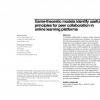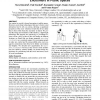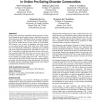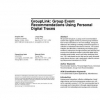CSCW
2016
ACM
8 years 7 months ago
2016
ACM
Crowdsourcing is a common strategy for collecting the “gold standard” labels required for many natural language applications. Crowdworkers differ in their responses for many r...
CSCW
2016
ACM
2016
ACM
Game-theoretic models identify useful principles for peer collaboration in online learning platforms
8 years 7 months ago
CSCW
2016
ACM
8 years 7 months ago
2016
ACM
Eye contact is crucial to shared encounters in public spaces. However, most urban technologies that aim to foster social interaction tend to rely on screens, directing a significa...
CSCW
2016
ACM
8 years 7 months ago
2016
ACM
Social media has emerged as a promising source of data for public health. This paper examines how these platforms can provide empirical quantitative evidence for understanding die...
CSCW
2016
ACM
8 years 7 months ago
2016
ACM
Theorists and advocates of “remixing” have suggested that appropriation can act as a pathway for learning. We test this theory quantitatively using data from more than 2.4 mil...
CSCW
2016
ACM
8 years 7 months ago
2016
ACM
One of the primary goals of academic conferences is to promote scientific exchange of advances among people who may otherwise not have the opportunity to hear from one another. W...
CSCW
2016
ACM
8 years 7 months ago
2016
ACM
Social media sites have struggled with the presence of emotional and physical self-injury content. Individuals who share such content are often challenged with severe mental illne...
CSCW
2016
ACM
8 years 7 months ago
2016
ACM
We present GroupLink, a group event recommendation system that suggests events to promote group members’ face-to-face interactions in non-work settings. GroupLink addresses the ...
CSCW
2016
ACM
8 years 7 months ago
2016
ACM
Pervasive information streams that document people and their routines have been a boon to social computing research. But the ethics of collecting and analyzing available—but pot...
CSCW
2016
ACM
8 years 7 months ago
2016
ACM
We discuss the multi-ethnic tension and social dynamics behind toxicity in online game Dota 2. We present a player survey and preliminary analysis of user-generated keywords and f...




